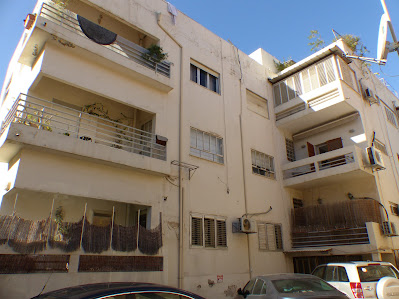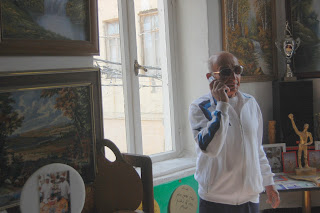Four Views From the Roof - Introduction
Four Views From the Roof
Introduction
In 1994, against the advice of friends and family, we managed to scrape together the deposit for a dilapidated three room, third floor flat in an old apartment building on Yehuda Halevi Street in south Tel Aviv. It was all we could afford if we wanted to put down a stake in Tel Aviv.
The building and its environs literally reeked of negligence. The once impressive but now deserted building opposite ours that had once served as a courthouse, was populated by drunks and junkies. To the west was tumbledown Neve Tzedek just starting to attract artists and students. To the east was a business area heavy on cheap eateries, wholesale textiles and low-end fashion outlets. Old men on tricycles navigated long bales of textiles against the traffic on the narrow streets (and still do). On parallel Lilienblum Street, dubious characters would whisper “Dollar? Dollar?” to passers-by interested in by-passing official restrictions against holding foreign currency.
Yet it didn’t take us long to realise that, behind the scruffy exterior, we had, by chance, landed in a fascinating location. Our building was situated between Neve Tzedek - the first Jewish suburb of Jaffa - and Tel Aviv - the ‘First Hebrew City’. In fact, the whole area was packed with character and history, interesting architecture, streets alive with commerce and trades and a heterogeneous human mix not to be found in north where we had spent our first four Tel Aviv years. We also discovered that our building, completed in 1937, was in the “Bauhaus” or “International Style”, soon to become fashionable in Israeli architecture and popular on the Tel Aviv real estate market. To cap it all, it was also close to the beach.
The deck we built on the roof above our apartment provides an elevated view of the Mediterranean and catches the sea breeze. Standing there gives you the illusion of standing on the prow of a ship, separated from the city that you know spreads all around you. It was probably this vantage point that gave me the idea of trying to write about the city I have inhabited for the past thirty two years, and have grown to love.
Soon, that vantage point will disappear. Our listed Bauhaus building is now aged 85 and is showing every sign of wear and tear. If all goes well, it will soon be strengthened, rejuvenated and beautified by means of a conservation and building project. But the simple old roof with its whitewashed walls and the little budkeh - originally used as a communal laundry – will be gone. Another reason to exploit the rooftop perspective while I still can.
Having made the decision, all I had to do was carry out my project. This involved over a year of digging into Tel Aviv’s history and excavating my own thoughts and personal experiences.
One of the things I discovered along the way was a relative lack of detailed information in English. The best source of historical information and photos, tlv100 – the online Tel Aviv encyclopaedia - is available only in Hebrew. A Wikipedia entry on say, Meir Dizengoff, will be far more comprehensive in Hebrew than in English. So hopefully, Four Views From the Roof will find its way to non-Hebrew speakers interested in knowing more about Tel Aviv and its history.
Four Views From the Roof is made up of four chapters, each discussing a compass direction as seen from the roof. While I have tried to make each chapter self-standing, anyone interested in the full story is advised to read the chapters in the order in which I wrote them: West, East, South, North.
Special thanks to Batya Shomrony for opening up her library, to Edna Gurney for her literary advice and to my wife Avril for her wise feedback and editing.
David Kriss
June 2022
Facing Jaffa 2009
Among books consulted:
Not in Jaffa and Not in Tel Aviv – Stories, testimonies and documents from the Shapira Neighbourhood, edited by Muki Tzur and Sharon Rothbard. (Hebrew only)
Blue and White in Color: Visual Images of Zionism 1897-1947 edited by Rachel Arbel (English)
A Dream That Became a Metropolis – Tel Aviv, Birth and Growth: the City that Spawned a State by Ilan Shchori (Hebrew only)
White City, Black City by Sharon Rothbard (I read the 2005 Hebrew version but an English version was published in 2015).
City of Oranges – Arabs and Jews in Jaffa by Adam LeBor (English only and highly recommended)
The Early Years of Tel Aviv, 1909-1934, Edited by Dr. Mordechai Naor (Hebrew only)
Imprisoned by its Images -A Short History and Profile of the State of Tel Aviv, by Prof. Maoz Azaria (Hebrew only)
The History of Tel Aviv – From Neighbourhoods to a City 1909-1936. by Ya’akov Shavit and Gidon Biger. (Hebrew only)
The Days of Dizengoff – Tel Aviv 1909 -1936 by Yoav Regev (Hebrew only)
5 Yehuda Halevi Street 2019
Ⓒ David Kriss 2022
All rights reserved






Comments